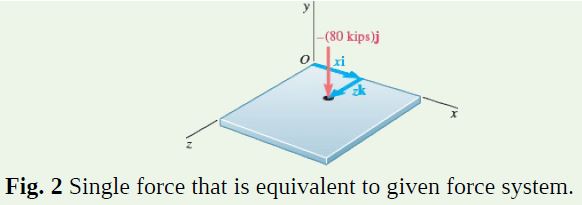Question 3.SP.11: A square foundation mat supports the four columns shown. Det...
A square foundation mat supports the four columns shown. Determine the magnitude and point of application of the resultant of the four loads.
STRATEGY: Start by reducing the given system of forces to a force-couple system at the origin O of the coordinate system. Then, reduce the system further to a single force applied at a point with coordinates x, z.

Learn more on how we answer questions.
MODELING: The force-couple system consists of a force R and a couple vector \pmb{M}_O^R defined as
R = ΣF \pmb{M}_O^R = Σ(r × F)
ANALYSIS: After determining the position vectors of the points of application of the various forces, you may find it convenient to arrange the computations in tabular form. The results are shown in Fig. 1.
| r, ft | F, kips | r × F, kip.ft |
| 0 | -40j | 0 |
| 10i | -12j | -120k |
| 10i + 5k | -8j | 40i – 80k |
| 4i + 10k | -20j | 200i – 80k |
| R = -80j | \pmb{M}_O^R =240i – 280k |
The force R and the couple vector \pmb{M}_O^R are mutually perpendicular, so you can reduce the force-couple system further to a single force R. Select the new point of application of R in the plane of the mat and in such a way that the moment of R about O is equal to \pmb{M}_O^R. Denote the position vector of the desired point of application by r and its coordinates by x and z (Fig. 2). Then
r × R = \pmb{M}_O^R
(xi + zk)×(−80j) = 240i − 280k
−80xk + 80zi = 240i − 280k
It follows that
−80x = −280 80z = 240
x = 3.50 ft z = 3.00 ft
The resultant of the given system of forces is
R = 80 kips ↓ at x = 3.50 ft, z = 3.00 ft
REFLECT and THINK: The fact that the given forces are all parallel simplifies the calculations, so the final step becomes just a two-dimensional analysis.

